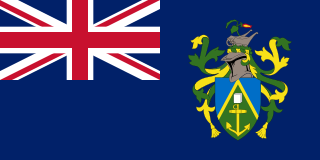
Sawfishes, also known as carpenter sharks, are a family of rays characterized by a long, narrow, flattened rostrum, or nose extension, lined with sharp transverse teeth, arranged in a way that resembles a saw. They are among the largest fish with some species reaching lengths of about 7–7.6 m (23–25 ft). They are found worldwide in tropical and subtropical regions in coastal marine and brackish estuarine waters, as well as freshwater rivers and lakes.

The lane snapper is a species of snapper native to the western Atlantic Ocean from North Carolina to southern Brazil, including the Gulf of Mexico and the Caribbean Sea. It can be found in a wide range of habitats, though it prefers coral reefs and sandy areas with plentiful vegetation. It occurs at depths from 10 to 400 m, most frequently between 21 and 70 m.

The smalltooth sand tiger or bumpytail ragged-tooth is a species of mackerel shark in the family Odontaspididae, with a patchy but worldwide distribution in tropical and warm temperate waters. They usually inhabit deepwater rocky habitats, though they are occasionally encountered in shallow water, and have been known to return to the same location year after year. This rare species is often mistaken for the much more common grey nurse shark, from which it can be distinguished by its first dorsal fin, which is larger than the second and placed further forward. It grows to at least 4.1 m (13.5 ft) in length.

The bigeye sand tiger is an extremely rare species of mackerel shark in the family Odontaspididae, with a possible worldwide distribution. A large, bulky species reaching at least 3.6 m (12 ft) in length, the bigeye sand tiger has a long bulbous snout, large orange eyes without nictitating membranes, and a capacious mouth with the narrow teeth prominently exposed. It can be distinguished from the similar smalltooth sand tiger by its teeth, which have only one lateral cusplet on each side, and by its uniformly dark brown color.
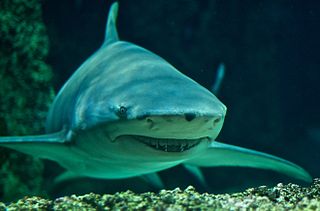
The sicklefin lemon shark or sharptooth lemon shark, is a species of requiem shark belonging to the family Carcharhinidae, widely distributed in the tropical waters of the Indo-Pacific. It is closely related to the better-known lemon shark of the Americas; the two species are almost identical in appearance, both being stout-bodied sharks with broad heads, two dorsal fins of nearly equal size, and a plain yellow-tinged coloration. As its common name suggests, the sicklefin lemon shark differs from its American counterpart in having more falcate (sickle-shaped) fins. This large species grows up to 3.8 m (12 ft) long. It generally inhabits water less than 92 m (302 ft) deep in a variety of habitats, from mangrove estuaries to coral reefs.

The longcomb sawfish, narrowsnout sawfish or green sawfish is a species of sawfish in the family Pristidae, found in tropical and subtropical waters of the Indo-West Pacific. It has declined drastically and is now considered a critically endangered species.
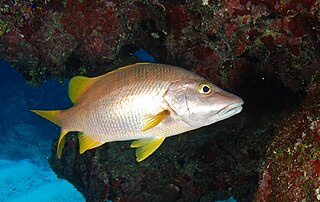
The schoolmaster snapper is a colorful, subtropical fish found over coral reef areas along the coasts of Florida, the Bahamas, and the Caribbean, though it can range northward along the Atlantic coast of the United States. Adults are 12–14 in (30–35 cm) long and weigh 1.0–2.0 lb (0.4–0.8 kg), though rare individuals can weigh 8 lb at 24 in long. It has a robust, slightly compressed body, with a pointed head. Its color varies from silvery to bronze. Fins and tails are yellow and the snout contains blue stripes. As the common name suggests, schoolmaster snapper live in groups of dozens of subjects. They keep a short distance from the sea floor at depths between 10 and 90 ft, prefer the cover provided by coral reefs during the day, and expand their range to seagrass beds at night. The schoolmaster snapper is sometimes called the barred snapper or the caji. Like other snapper species, it is a popular food fish.
The tiger grouper is a benthic marine fish which belongs to the family Serranidae or also known as the groupers.

The red porgy, or common seabream, is a species of marine ray-finned fish in the family Sparidae. It is found in shallow waters on either side of the Atlantic Ocean, being present on the western coast of Europe and the Mediterranean Sea as well as the eastern coasts of North and South America and the Caribbean Sea. It feeds on or near the seabed and most individuals start life as females and later change sex to males.
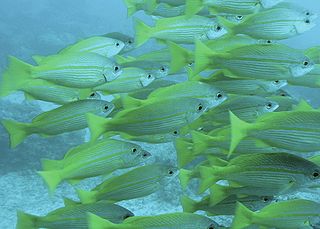
The bigeye snapper, also known as the bigeye snapper, big-eye snapper, bigeye seaperch, red sea lined snapper, golden striped snapper, tropical snapper, rosy snapper, yellow snapper, or simply snapper, is a species of snapper native to the Indian Ocean and the western Pacific Ocean. It inhabits offshore coral reefs at depths from near the surface to 96 m (315 ft). This species is mostly silver in color with a yellow stripe along the side and fainter yellow lines on the lower half of the body. Fins are yellowish to whitish. It can reach a length of 35 cm (14 in).

The [common] bluestripe snapper, bluestripe sea perch or blue-line snapper, Lutjanus kasmira, is a species of snapper native to the Indian Ocean from the coast of Africa and the Red Sea to the central Pacific Ocean. It is commercially important and sought as a game fish. It can also be found in the aquarium trade.

Pristipomoides filamentosus, commonly known as the crimson jobfish, crimson snapper, opakapaka, or Hawaiian pink snapper, is a species of snapper native to the Indian Ocean and into the Pacific Ocean as far east as Hawaii and Tahiti. They inhabit waters over rocky substrates at depths from 40 to 400 m seemingly preferring to remain between 180 and 270 m. This species can reach a length of 100 cm (39 in), though most are around 50 cm (20 in). The greatest known weight for this species is 8.2 kg (18 lb). This species is very important to local commercial fisheries and is sought out as a game fish. One of the Deep Seven species of Hawai'i.

South Pacific is a British nature documentary series from the BBC Natural History Unit, which began airing on BBC Two on 10 May 2009. The six-part series surveys the natural history of the islands of the South Pacific region, including many of the coral atolls and New Zealand. It was filmed entirely in high-definition. South Pacific was co-produced by the Discovery Channel and the series producer was Huw Cordey. It is narrated by Benedict Cumberbatch. Filming took place over 18 months in a variety of remote locations around the Pacific including: Anuta, Banks Islands, French Frigate Shoals, Papua New Guinea, Palmyra, Kingman Reef, Tuvalu, Palau, Caroline Islands, Tuamotus and Tanna Island in Vanuatu.

Coral reef fish are fish which live amongst or in close relation to coral reefs. Coral reefs form complex ecosystems with tremendous biodiversity. Among the myriad inhabitants, the fish stand out as colourful and interesting to watch. Hundreds of species can exist in a small area of a healthy reef, many of them hidden or well camouflaged. Reef fish have developed many ingenious specialisations adapted to survival on the reefs.

Coastal fish, also called inshore fish or neritic fish, inhabit the sea between the shoreline and the edge of the continental shelf. Since the continental shelf is usually less than 200 metres deep, it follows that pelagic coastal fish are generally epipelagic fish, inhabiting the sunlit epipelagic zone. Coastal fish can be contrasted with oceanic fish or offshore fish, which inhabit the deep seas beyond the continental shelves.
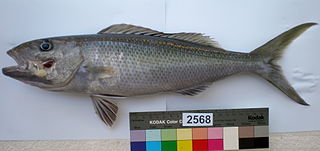
The green jobfish, Aprion virescens, is a species of snapper native to the Indian and Pacific Oceans from the African coast to the Hawaiian Islands. This species inhabits various reef environments at depths from near the surface to 180 ft (55 m). This species grows to a length of 112 cm (44 in), though most do not exceed 90 cm (35 in). The greatest reported weight for this species is 15.4 kg (34 lb). It is a very important species for local commercial fisheries and is popular as a game fish, though it has been reported to cause ciguatera poisoning. It can also be found in the aquarium trade. This species is the only known member of its genus.

Fishing is important to the national economy of Vanuatu. It is the main source of income for many in the islands and Vanuatu's biggest export. According to 2009 figures, approximately 77% of households in Vanuatu are involved in fishing activity. According to 2005 figures, Vanuatu caught 151,080 fish in that year, with frozen fish accounted for half of Vanuatu's commodity exports.
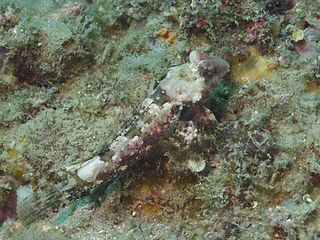
Morrison's dragonet is a species of dragonet. It is native to the southwest Pacific Ocean from Japan to Australia ant eastwards to the Marshall Islands and Fiji. The specific name honours J.P.E. Morrison (1906-1983), the U.S. malacologist who was curator of molluscs at United States National Museum and who spent the summers of 1947 and 1948 at Bikini Atoll.

Lutjanus johnii, commonly known as John's snapper or the golden snapper, is a marine fish native to the western Pacific and Indian Oceans, from East Africa to Fiji and Australia. In Queensland, Northern Territory and other parts of Australia it is perhaps known more commonly as Fingermark bream, and is arguably one of the best estuary eating fish. The former name is generally used when the fish is in much larger sizes, with juveniles and young adults usually referred to as the latter ('Fingermark'). It has a remarkably slow growth rate, so release is encouraged and bag limits apply. It can grow to approximately 8 kg in weight although 10 kg fish have been recorded off the coast of Cairns, though even a small individual will provide a substantial fight. They are not recommended to be targeted for catch and release when fishing in depths of 10 m or over, as the species is highly susceptible to barotrauma. Fingermark encounters often occur when targeting other species such as barramundi, and can be distinguished by their golden-brown to reddish skin tint and dark 'fingermark' beneath the dorsal fin – colourations both lost as the species dies once taken from the water or grows in size. Colourations are extremely prominent in juvenile fish. They are members of the snapper genus Lutjanus, which also includes mangrove jack and other well-known table species.






